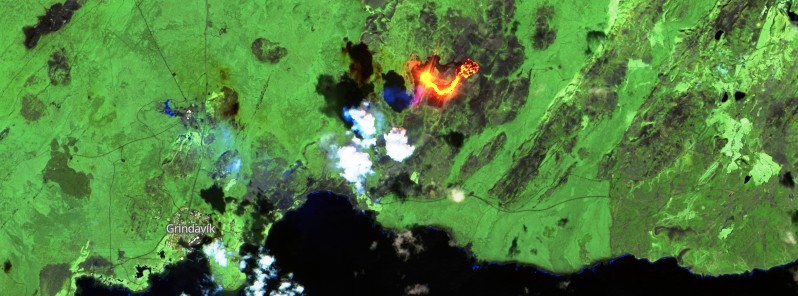Lava flow at Fagradalsfjall increases by 70 percent amid ongoing eruption, Iceland

Lava flow at the Fagradalsfjall eruption site on Iceland's Reykjanes Peninsula has increased by around 70 percent, according to the latest data from the University of Iceland’s Institute of Earth Sciences (IES). Experts also noted that there are no signs that the ongoing volcanic eruption will stop soon. Despite the dangers, many visitors ventured near the perimeter to witness the spectacular sight of lava geysers.
Data gathered on May 10 showed that lava flow at the Geldingadalir eruption increased significantly in the past week, from 8 to 13 m3 per sec (282 to 459 cubic feet per sec).
Although a security perimeter has been enforced to protect people from the hazards of falling hot rocks, many locals walk near the volcano to witness huge lava geysers.
"It's not every day we can go to look at a volcano so close. It's just really amazing and so beautiful," said Freyja Wappler-Fridriksdottir, who was among more than 2 500 people who visited the site on the weekend.
According to the national meteorological office, some lava geysers have reached unusual heights beyond 460 m (1 500 feet).
As of Monday, May 10, authorities have closed the eruption site due to the risk of wildfires. The police initially received a report of a fire at Laugarnestangi, which turned out to be an isolated case.
Tourists were treated to an explosive display on the Reykjanes Peninsula in Iceland as the #Fagradalsfjall volcano continued to erupt this week pic.twitter.com/a3LXZ8TqkV
— The Weather Network (@weathernetwork) May 9, 2021
pretty busy today#Fagradalsfjall pic.twitter.com/uRA8WmSjeO
— salohah (@salohah1) May 10, 2021
The tools vs the shot #Geldingadalir #Iceland #volcano @VisitReykjanes @SonyUK pic.twitter.com/RjugtwIJuY
— Páll Jökull | Photo guide in #Iceland (@Palljokull) May 10, 2021
Image aquired in between two explosions #Geldingadalir : timing and teamwork @VTLAB_Joel saved our @Wingtra drone :)! pic.twitter.com/Ey3qzhFH32
— Joël Ruch (@VTLAB_Joel) May 7, 2021
"Increased flow has gone hand in hand with rising lava fountains and a powerful advance of lava into Meradalir valley," the institute said in a statement issued Tuesday, May 11. "The eruption is now twice as powerful as it has been for most of the active period."
The volume of lava emitted, which has lasted for nearly eight weeks so far, has now reached more than 30 million m3 (1 billion cubic feet).
The Geldingadalir eruption is particularly exceptional in that the wide majority of eruptions decrease in intensity after they begin.
"An increase with time indicates that the channel is widening, probably due to a break in its walls. It can not be seen that the pressure in the source has decreased to a certain extent and therefore the flow increases over time as the channel expands," wrote IES.
"There is currently no way to predict how long the eruption will last or whether lava flows will continue to increase."



Geological summary
The Krýsuvík-Trölladyngja volcanic system is described by the Catalogue of Icelandic Volcanoes as an approximately 50 km (31 miles) long composite fissure swarm trending about N38°E, including a 30 km (18 miles) long swarm of fissures, with no central volcano.
It is one of the volcanic systems arranged en-echelon along the Reykjanes Peninsula west of Kleifarvatn lake.
The Fagradalsfjall and Krýsuvík fissure swarms are considered splits or secondary swarms of the Krýsuvík–Trölladyngja volcanic system.
Small shield volcanoes have produced a large portion of the erupted volume within the system.
Several eruptions have taken place since the settlement of Iceland, including the eruption of a large basaltic lava flow from the Ogmundargigar crater row around the 12th century.
The latest eruption, identified through tephrochronology, took place during the 14th century.
Featured image credit: Copernicus EU/Sentinel-2, TW. Acquired May 9, 2021.

Commenting rules and guidelines
We value the thoughts and opinions of our readers and welcome healthy discussions on our website. In order to maintain a respectful and positive community, we ask that all commenters follow these rules:
We reserve the right to remove any comments that violate these rules. By commenting on our website, you agree to abide by these guidelines. Thank you for helping to create a positive and welcoming environment for all.